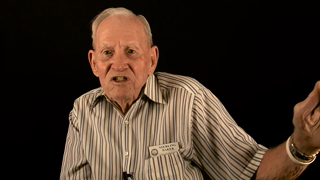5:59 | The USS Almaack had been repaired and upgraded and headed out again, this time to the Pacific. Coxswain Sterling Baker had moved up the food chain to hatch leader, supervising the unloading and loading of landing craft. During an air attack, he became a 20mm gunner. At Saipan, he looked through his gun sight toward shore and saw something disturbing.
Keywords : Sterling Baker Y gun depth charge cargo Sherman tank 20mm gun Honolulu HI Saipan Tinian B-29 general quarters coxswain hatch leader tugboat (tug) dogfight tracer suicide

Sterling Baker had been trying to join the Navy since he was fourteen and he finally succeeded in 1942. Trained as a coxswain in the amphibious force and assigned to the USS Leonard Wood, he had a short detour when he went AWOL because the others had leave after boot camp and he didn't. This would prove fateful when he visited his girlfriend and fell for her roommate.
Sailor Sterling Baker saw a note on the bulletin board asking for volunteers who were single, had no close family ties and who were excellent swimmers. Off he went to become an amphibious scout, one of the precursors to today's SEALS. Armed with only a knife, he was trained to infiltrate a beach undetected ahead of an amphibious landing. He did not get to try in his first operation at Algiers.
After a successful operation at Algiers, The USS Almaack was headed back to England when it was torpedoed off Portugal. Sterling Baker was in his bunk when it hit and, though the ship remained afloat, he never slept below deck again. While repairs were underway, he served in Casablanca, where he had a memorable Christmas.
Ashore at Guam during a lull in the fighting, the sailors of the USS Almaack started eating coconuts and drinking coconut milk. This caused quite a commotion in the toilet facilities later aboard ship. Sterling Baker relates what one old Chief did to get the line moving, and how someone got revenge.
At Leyte, Sterling Baker had to operate in a smoke screen, unloading landing craft and supplies for the invasion. It was unnerving because he could hear attacking aircraft above but he couldn't see them. When underway, the amphibious cargo assault ship would lower paravanes into the water, which would cut the mooring cables on mines so they could float to the surface for disposal.
Sterling Baker had to wait several days to get all his cargo unloaded at Iwo Jima because of the slow advance inland. This was his last action and he was transferred to Alameda Naval Air Station where he manned a converted PT boat used for rescue operations. He reflects on his scout training that he never got to use.